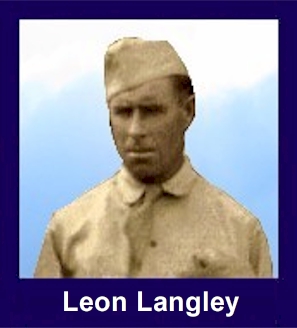The 35th Infantry Regiment Association salutes our fallen brother, PFC Leon W. Langley, 38318899, who died in the service of his country on April 17th, 1945 in Luzon. The cause of death was listed as KIA. At the time of his death Leon was 24 years of age. He was from Sequoyah County, Oklahoma.
The decorations earned by PFC Leon W. Langley include: the Combat Infantryman Badge, the Bronze Star, the Purple Heart, the Asiatic-Pacific Service Medal, and the World War II Victory Medal.
Son of Levi and Emma Langley. Leon was an American Indian and a barber in civilian life.
Burial:
Blackjack Cemetery
Blackjack
Sequoyah County
Oklahoma, USA
(From Perry Ball's "Sgt Roach's Story")
E and F Companies attacked while G Company remained in reserve on the small hill at the end of the ridge on 17 April. G Company's reserve status did not spare it from additional fighting and some of the heaviest casualties it suffered during the Luzon Campaign.
Cpl. Charles R. Sheaffer of the 1st Section, Heavy Machine Gun Platoon, H Company described what happened on the hill that morning. He recalled that they had driven the Japanese from the hill on 16 April. They then set up a perimeter defense around the top of the hill and the Japanese were all around them. They closed in during the night and conducted a Banzai attack at sunrise on the morning of 17 April. Sheaffer's 1st Section was at the point of the attack. The Japanese charged dead-on to where Sheaffer shared a foxhole with Section Leader SSGT Eugene F. Cribelar, which was located between two H Company heavy machine guns. Sheaffer was directing fire when he was hit by a bullet in his right shoulder. The 1st Platoon, H Company Medic, Pfc. Harold "Doc" Winder, treated Sheaffer immediately and continued to care for him until a team of litter bearers arrived from the 2nd Battalion Headquarters to carry him down the hill. Winder told Sheaffer later that morning that 36 Japanese had been killed during the Banzai attack. The litter team was delayed by six hours because the Japanese had cut the evacuation route. The team finally got through in the afternoon and carried him about five miles to where he was put on a rack on top of a jeep that took him to a rice paddy where there was a temporary air strip. He was then strapped into the underside of a Piper Cub airplane since there was not enough room for the stretcher inside the airplane and flown to a field hospital at Quezon City east of Manila. It was midnight when a field surgeon cleaned his wound.
Sgt. Hardin wrote that, "We surely caught hell today. The Japs killed two of our men just before and about daybreak this A.M. and wounded three or four others…A patrol of Japanese from our rear walked right straight into our lines on my side of the perimeter this A.M. just at daybreak. They were within 5 to 6 yards before anyone opened fire. This hill is about a 45 degree slope on my side and the Nips were climbing this. All of us opened fire, and four are laying in plain sight of my position. I don't think I could have hit any of these as I was shooting blind with the machine gun tracers. My bullets were landing in the brush were these came from and where what was left of them went to as soon as the fireworks started. (Pfc.) Lange just about swears he killed at least two of the Nips. We are about to tease him nuts about his claims. (Pfc.) Langly got it through the throat from one of these Japs, and the machine gunner below me (Cpl. Sheaffer) got it pretty hard (he is from H Company). I guess our whole company got at least 15 or 20 Japs last night and this A.M. early."
The rest of the Japanese soldiers escaped back into the ravine. Shortly afterwards, Pfc. Leon W. Langley, a Cherokee Indian from the 3rd Platoon, rose up in his foxhole to get a better view of the enemy down in the ravine. One of the escaping Japanese soldiers shot him under the chin and the bullet went through his skull and took off the top of his head. He died instantly.i
|




